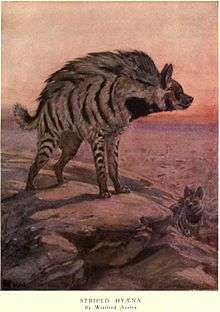Winifred Austen
Winifred Maria Louise Austen (1876 – 1 November 1964) was an English illustrator, painter, etcher and aquatint engraver.
Early years and education
Born in Ramsgate, Kent, in 1876, her parents were Josiah Austin, a Cornish naval surgeon, and Fanny (née Mann) Austin. She was educated privately by a Mrs. Louise Jopling-Rowe and Mr. Cuthbert E. Swan.[1][2]
Career



Austen's favorite subjects were wild animals, and she was successful in the illustration of books. Her etchings of animals and birds were popular in the 1940s and 1950s.[3] At the Royal Academy in 1903, she exhibited "The Day of Reckoning", a wolf pursued by hunters through a forest in snow. A second show a snow scene, featured a wolf baying, while two others are apparently listening to him. "While the wolf, in nightly prowl, bays the moon with hideous howl," is the legend with the picture.[4][5][6]
Austen was described as having great talent with the rare gift of sympathy with the animal world. For many seasons, she exhibited regularly at the annual exhibition of the Royal Society of Painter Etchers, and in 1922, she was elected a member of that society.[2] Austen's early plates were overloaded with background, which the artist ultimately completely discarded. The Little Egret is lost in its surroundings. The plate lacked atmosphere, however much it may have appealed to the ornithologist. The otherwise nicely done Country Mouse suffered from the same fault. Austen was overly engrossed in the animals such that her work upon branches, leaves and blossoms demonstrated signs of a weakened interest. She was also not at her best when drawing exotic birds or beasts, such as a stork or a bear. The Belgian Hare and the Rabbit are works of a middle period. While the Rabbit is considered the finer of the two. Austen, without over-labouring her plate, adopted a severe method for some of her strokes. Austen etched two game birds, the Little jap and A Surrey Fowl. The first is considered good, the second bears comparison with Félix Bracquemond's work. Austen’s etched line was bold and firm, with an absence of fumbling and indecision. The drypoints were her most recent works. Austen came under the inspiration of the Japanese. A drawing by Keibun Ōta in the British Museum of mallard flying by moonlight may be compared with Austen's Mallard Pitching. Mallard Rising deals with a similar subject. Widgeon in Winter and A Little Covey are considered good drypoints, the latter showing strong Japanese influence.[6] Austen was elected to the Society of Women Artists (1902), the Royal Society of Painter-Etchers and Engravers (1907), the Royal Institute of Painters in Water Colours (1933), and from 1903, she was a fellow of the Royal Zoological Society.[4]
Austen married her agent Oliver O'Donnell Frick in 1917 and was widowed in 1923.[7][3] In 1926 she moved to a cottage in Suffolk where she remained for the rest of her life.[3] She died at Bickley, in 1964.[4] Her pictures are held in private collections.[5]
Books illustrated
- A Book of Dogs by E Nesbit, 1898, published by Dent
- At the Zoo by A Cooke, 1920, published by Nelson
- Field, River and Hill by E Parker, 1927, published by Allan
- Marsh and Mud Flat by K Dawson, 1931, published by Country Life
- Just an Oridinary Shoot, 1935, Country Life
- Birds Ashore and Aforeshore by P Chalmers, 1935, published by Collins.[3]
References


- David Buckman (2006). Artists in Britain Since 1945 Vol 1, A to L. Art Dictionaries Ltd. ISBN 0 953260 95 X.
- Grant M. Waters (1975). Dictionary of British Artists Working 1900–1950. Eastbourne Fine Art.
- Alan Horne (1994). The Dictionary of 20th Century British Book Illustrators. Antique Collectors' Club. ISBN 1 85149 1082.
- "Winifred Maria Louise Austen 1876 - 1964 SWLA (1905), ARE (1907), RE (1922), RI (1925)". The Wildlife Art Gallery. Retrieved 29 March 2015.
- Waters, Clara Erskine Clement (1904). Women in the Fine Arts: From the Seventh Century B.C. to the Twentieth Century A.D. (Public domain ed.). Houghton, Mifflin. pp. 21–.
- The Bookman's Journal and Print Collector (Public domain ed.). "The Bookman's journal and print collector" Company. 1922. pp. 43–.
- Gray, Sara. The Dictionary of British Women Artists. Casemate Publishers. pp. 26–. ISBN 978-0-7188-3084-7.